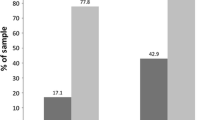Abstract
Purpose
To evaluate the alpha angle of the hip in patients with noncontact anterior cruciate ligament (ACL) injury and compare it with patients without injury. In addition, external and internal rotation of the hip was assessed and correlated with the alpha angle.
Methods
The alpha angle of the ipsilateral hip was assessed in 41 subjects with non-contact ACL tear and compared with 39 subjects with no tear. The external and internal rotation of the ipsilateral hip was also evaluated.
Results
The alpha angle was larger in subjects with noncontact ACL injury. The mean was 70.31° (±13.92°) compared with 58.55° (±13.95°) in the control group (p < 0.001). The groups were similar when considering the external, internal, and sum of rotation of the ipsilateral hip. There was no correlation between the alpha angle and decreased rotational range of motion of the hip in either group (p > 0.05).
Conclusion
Patients with noncontact ACL injury presented a greater alpha angle when compared with the group without tear. There was no difference in the rotational mobility of the hip between groups, nor was there a correlation between the increase in the alpha angle and the decrease in the rotational mobility of the hip.



Similar content being viewed by others
References
Albright JC, Carpenter JE, Graf BK, Richmond JC (1999) Knee and leg: soft tissue trauma. In: Beauty JH (ed) Orthopaedic knowledge update 6. Rosemont, American Academy of Orthopaedic Surgeons, pp 533–557
Arnoczky SP (1983) Anatomy of the anterior cruciate ligament. Clin Orthop Relat Res 172:19–25
Harner CD, Baek GH, Vogrin TM, Carlin GJ, Kashiwaguchi S, Woo SL (1999) Quantitative analysis of human cruciate ligament insertions. Arthroscopy 15:741–749
Gabriel MT, Wong EK, Woo SL, Yagi M, Debski RE (2004) Distribution of in situ forces in the anterior cruciate ligament in response to rotatory loads. J Orthop Res 22:85–89
Lambson RB, Barnhill BS, Higgins RW (1996) Football cleat design and its effect on anterior cruciate ligament injuries: a three-year prospective study. Am J Sports Med 24:155–159
Souryal TO, Freeman TR (1993) Intercondylar notch size and anterior cruciate ligament injuries in athletes: a prospective study. Am J Sports Med 21:535–539
Gomes JLE, Castro JV, Becker R (2008) Decreased hip range of motion and noncontact injuries of the anterior cruciate ligament. Arthroscopy 24:1034–1037
Tainaka K, Takizawa T, Kobayashi H, Umimura M (2014) Limited hip rotation and non-contact anterior cruciate ligament injury: a case-control study. Knee 21:86–90
Philippon M, Dewing C, Briggs K, Steadman JR (2012) Decreased femoral head–neck offset: a possible risk factor for ACL injury. Knee Surg Sports Traumatol Arthrosc 20:2585–2589
Johnson AC, Shaman MA, Ryan TG (2012) Femoroacetabular impingement in former high-level youth soccer players. Am J Sports Med 40:1342–1346
Agricola R, Bessems JH, Ginai AZ, Heijboer MP, van der Heijden RA, Verhaar JA et al (2012) The development of cam-type deformity in adolescent and young male soccer players. Am J Sports Med 40:1099–1106
Gosvig KK, Jacobsen S, Palm H, Sonne-Holm S, Magnusson E (2007) A new radiological index for assessing asphericity of the femoral head in cam impingement. J Bone Joint Surg Br 89:1309–1316
Boone DC, Azen SP (1979) Normal range of motion of joints in male subjects. J Bone Joint Surg Am 61:756–759
Allander E, Bjornsson OJ, Olafsson O, Sigfusson N, Thorstenisson J (1974) Normal range of joint movements in shoulder, hip, wrist and thumb with special reference to side: a comparison between two populations. Int J Epidemiol 3:253–261
De Castro JV, Machado KC, Scaramussa K, Gomes JLE (2013) Incidence of decreased hip range of motion in youth soccer players and response to a stretching program: a randomized clinical trial. J Sport Rehabil 22:100–107
Van Trijffel E, de Pol RJ, Oostendorp RA, Lucas C (2010) Inter-rater reliability for measurement of passive physiological movements in lower extremity joints is generally low: a systematic review. J Physiother 56:223–235
Ellera Gomes JL, Palma HM, Becker R (2010) Radiographic findings in restrained hip joints associated with ACL rupture. Knee Surg Sports Traumatol Arthrosc 18:1562–1567
Ellera Gomes JL, Palma HM, Ruthner R (2014) Influence of hip restriction on noncontact ACL rerupture. Knee Surg SportsTraumatol Arthrosc 22:188–191
Beaulieu ML, Wojtys EW, Ashton-Miller JA (2015) Risk of anterior cruciate ligament fatigue failure is increased by limited internal femoral rotation during in vitro repeated pivot landings. Am J Sports Med 43:2233–2241
Bedi A, Warren RF, Wojtys EM, Oh YK, Ashton-Miller JA, Oltean H, Kelly BT (2014) Restriction in hip internal rotation is associated with an increased risk of ACL injury. Knee Surg Sports Traumatol Arthrosc 24:2024–2031
Bedi A, Dolan M, Leunig M, Kelly BT (2011) Static and dynamic mechanical causes of hip pain. Arthroscopy 27:235–251
Kelly BT, Bedi A, Robertson CM, Dela Torre K, Giveans MR, Larson CM (2012) Alterations in internal rotation and alpha angles are associated with arthroscopic cam decompression in the hip. Am J Sports Med 40:1107–1112
Author information
Authors and Affiliations
Corresponding author
Ethics declarations
Conflict of interest
The authors declare that they have no conflict of interest.
Funding
There is no funding source.
Ethical approval
The study was previously evaluated and approved by the Passo Fundo University Ethics Committee (#442.037).
Informed consent
Informed consent was obtained from all individual participants included in the study.
Rights and permissions
About this article
Cite this article
Lopes, O.V., Tragnago, G., Gatelli, C. et al. Assessment of the alpha angle and mobility of the hip in patients with noncontact anterior cruciate ligament injury. International Orthopaedics (SICOT) 41, 1601–1605 (2017). https://doi.org/10.1007/s00264-017-3482-6
Received:
Accepted:
Published:
Issue Date:
DOI: https://doi.org/10.1007/s00264-017-3482-6




